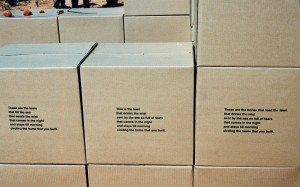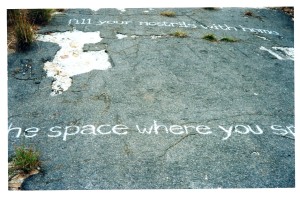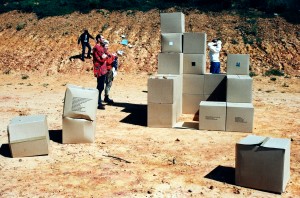(All photographs are taken from the Public Sculpture catalog)
The District Six Museum is located in Cape Town, South Africa. The museum is located in District Six, as a “result of exploration into the inner and outer working lives within the area. The museum seeks to uncover the many places where the institution has been involved in ways which link it back to its founding momentum, but takes it beyond its original boundaries” (Bonita Bennett, City Site Museum: Reviewing memory practices at the District Six Museum).
An active relationship to the site has been at the core of the Museum’s existence. Over the years, the relationship has been configured in different ways, but its embodiment both tangibly and metaphorically in the Museum space has remained constant.
In 1997, members of the community and museum came together in order to form what would later be called the “District Six Public Sculpture Project.” Renate Meyer stated in the introduction of the exhibition’s catalogue that they “had decided that the exhibition would serve as a forum for different voices. We did not therefore curate the exhibition in the traditional way, but saw ourselves as rather providing information, support and co-ordination to the participating artists” (Meyer, p.1). Works were created to inform rather than dominate the landscape and visitors. The artists had free reign on the sculpture but materials were important to reduce the possibility of vandalism or thief. On opening day, Tony Morphet states that the “line between accident and intention had begun to waver a bit” as visitors questioned if something was a sculpture or had it been there before, just overlooked (Morphet, p.8). As individuals continue down the paths to many different sculptures, they soon may start to piece together that the cardboard boxes could be the homes of returned district “sixers”.
This alternative form of sculpture not only stands for the physical markers of significant historical sites but also commemorating the people who once lived there. The District Six Public Sculpture Project has opened up the questions of traditional sculpture exhibitions by asking both the staff and visitor to revaluate how, why and in what form public sculptures can operate within. The sculptures not only make awareness of the emptiness of space, the void of what use to be, but also brings awareness of the people that still remain. While the residents of District Six have long since been removed and resettled in other areas of Cape Town, the memories of their homes remain.
In an article written by Emma Bedford and Tracy Murinik, they state that:
“the need to remember every detail of what has been lost haunts those who have lost it: the instinct of the amputee to exercise the absent limb. The urgent desire to re-establish the security of what is known and familiar; of that what reminds you of yourself, and says to others that you exist. The desolation that comes with losing your markers. The silence that comes being removed from your signals. The horror that consumes yourself now apparently invisible. Your existence doubted. You’re being negated, nullified, vulnerable to dispersal by the wind, your roots un-rooted. Your desires flouted; your needs unheard. Your voice left thin and in articulable. Your mind searching for proofs of what you are, and markers of what you were, and props for sustenance and survive” (Bedford, p. 12).
These are just a few of the feelings that can be felt by individuals that have been forced out of their homes and surroundings through the use of physical, mental, economic or a number of other forms of violence. No matter what the form, the scars remain. A poem written by Bedford and Murinik for the catalogue shows how the survivors of such tragedy need more than physicality:
“The need to remember to state your claim.
The need to remember to state your history.
The need to remember to state your family.
To stake your land. To plot your childhood.
To stake your humanity.
To hold on to your mind.
To resist the deadening losses.
To insist that it can never happen again.” (Bedford, p.13)
Artist Clive van den Berg’s use of fire within his sculpture promoted “reflections on how we remember, of the scars that exist, and on how we envision ourselves into the future. Invoking insight as to how we encounter memory, his images flickered into varying degrees of clarity and consciousness“(Bedford, p. 19).
For many returning residents, the sculpture project allowed for a moment for them to remember what use to be on the land. For many, the “commemorative voices, voices of survivors, voices of family members, voices of veterans, voices of people who have been involved in these extreme situations and speak out of the voice of experience: I was there; I know what happened” can be called out to the artists and those who come to see the exhibition (Cobb, p. 15).
——————————————————————————————————
I would like to personally thank the District Six Museum, staff, volunteers, and other participants in welcoming me into the museum in addition to helping me find my way into the history of the past and action of the present.
I would also like to thank the University of Illinois-Chicago Provost Award committee for receiving the grant that allowed me to work with the District Six Museum.
*Sources:
Cobb, Daniel M. and Helen Sheumaker. Memory Matters. State University of New York Press. 2011
Bedford, Emma and Tracy Murinik. “Re-membering that Place: Public Projects in District Six”.
The District Six Public Sculpture Project. District Six Museum. 1998.
Bennet, Bonita, Chrischene Julius and Carin Soudien. City – Site – Museum: Reviewing
Memory Practices and t he District Six Museum. District Six Museum. 2008.
Meyer, Renate. “Introduction”. The District Six Public Sculpture Project. District Six Museum.










